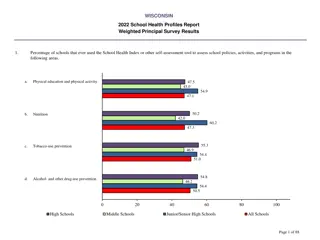
Women's Health and Wellness Tips
Discover valuable information on maintaining women's health, including tips on calculating BMI, lowering BMI through diet and exercise, annual check-ups, Pap smear guidelines, breast cancer screening, and statistics. Learn how to stay proactive about your health and well-being.
Download Presentation

Please find below an Image/Link to download the presentation.
The content on the website is provided AS IS for your information and personal use only. It may not be sold, licensed, or shared on other websites without obtaining consent from the author. If you encounter any issues during the download, it is possible that the publisher has removed the file from their server.
You are allowed to download the files provided on this website for personal or commercial use, subject to the condition that they are used lawfully. All files are the property of their respective owners.
The content on the website is provided AS IS for your information and personal use only. It may not be sold, licensed, or shared on other websites without obtaining consent from the author.
E N D
Presentation Transcript
Womens Health Talk Kelly Murguia, MSN, NP Reedley College Health Services Coordinator
Healthy Numbers BMI: Body Mass Index Calculates height/weight and is an easy method of screening for weight grouping, such as underweight, normal or healthy weight, overweight, and obesity. Normal/Healthy BMI=18.5 24.9 How to calculate: weight (lb) / [height (in)]2x 703 Example: I am 155 lbs. and 5 8 tall (68 ); 155/(68)2x 703 = 23.6 This is a guideline to assess risks for health concerns
Ways to lower BMI Change your diet Low-fat, low carb, high lean protein More fruits and vegies Increase water More Exercise Move daily, start with 30 minutes/day Aerobic activity burns more calories Add strength training with weights to tone muscle Increases metabolism Keep a journal Fitness app, Fitbit, Apple watch
Womens Health Yearly Women s Health Exam Covered by Insurance, Family PACT, and BCEDP Includes: Pap smear or Pelvic exam Clinical Breast Exam STD screening Birth control counseling Routine labs
Pap Smear Pap Smear: Screening for cervical cancer and detects HPV The only way to detect cervical cell change HPV is a sexually transmitted virus--over 100 HPV strains 4-6 harmful HPV strains Screening begins at age 21 New changes: Pap Smear every 3 years if Pap was normal last year Yearly pelvic exam if not due for a Pap
Breast Exam Clinical breast Screening for breast Cancer Monthly self breast exams--Screening for breast Cancer Yearly mammogram by age 40--Screening for breast Cancer BCEDP Program Free screening and mammogram
Breast Cancer Stats 2ndmost common cancer in American women with 249,000 new cases expected in 2016. In the US, 1 out of 8 women will develop breast cancer in their lifetime. Although rare, 2,600 new cases of invasive breast cancer are expected to be diagnosed in men this year (1 in 1000 risk). A women s risk of breast cancer nearly doubles if she has a first-degree relative who has been diagnosed with breast cancer. 5-10% of breast cancers can be linked to gene mutations (BRCA 1 & BRCA 2) inherited from one s parent.
STD Screen Gonorrhea and Chlamydia cervical screening HPV cervical screening STD screening Blood tests: HIV, RPR, Hepatitis Many STD s are asymptomatic STD Prevention = Condoms with every new partner
Labs Labs: STD Panel (HIV, Syphilis, Hepatitis) CBC (Hgb) CMP (BS) Thyroid panel
Birth Control Non-Hormonal Birth Control Condoms ** Hormonal Birth Control Oral Contraceptive Pill Diaphragm/Cap/Spermicide Nuvaring Natural Family Planning Patch ParaGard IUD Depo-Provera Essure/BTL Nexplanon Abstain/Hysterectomy Mirena & Skyla IUD
Which BC Method is Best? Questions to ask: 1. Do you want a long-term or short-term product? 2. Do you want a period? 3. Are you able to remember something daily? 4. Are you in a monogamous relationship? 5. What have you used in the past?
References https://www.asccp.org https://www.acog.org https://www.breastcancer.org https://www.knowbrca.org https://www.livestrong.com






















